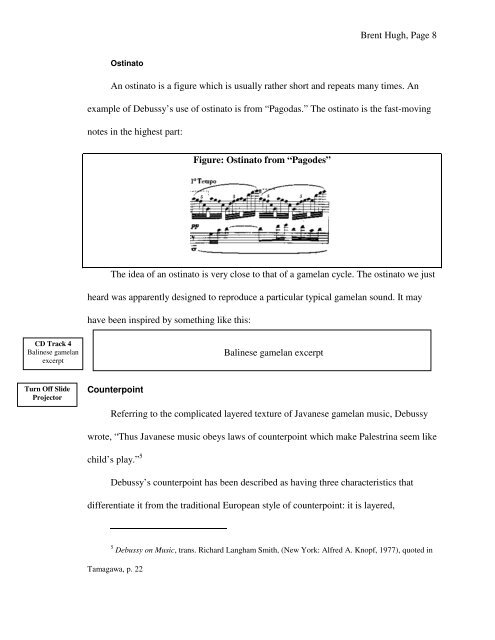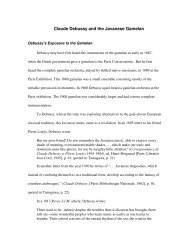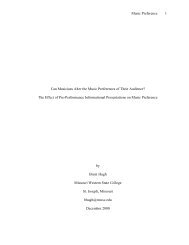Claude Debussy and the Javanese Gamelan
Claude Debussy and the Javanese Gamelan
Claude Debussy and the Javanese Gamelan
You also want an ePaper? Increase the reach of your titles
YUMPU automatically turns print PDFs into web optimized ePapers that Google loves.
CD Track 4<br />
Balinese gamelan<br />
excerpt<br />
Turn Off Slide<br />
Projector<br />
Ostinato<br />
Brent Hugh, Page 8<br />
An ostinato is a figure which is usually ra<strong>the</strong>r short <strong>and</strong> repeats many times. An<br />
example of <strong>Debussy</strong>’s use of ostinato is from “Pagodas.” The ostinato is <strong>the</strong> fast-moving<br />
notes in <strong>the</strong> highest part:<br />
Figure: Ostinato from “Pagodes”<br />
The idea of an ostinato is very close to that of a gamelan cycle. The ostinato we just<br />
heard was apparently designed to reproduce a particular typical gamelan sound. It may<br />
have been inspired by something like this:<br />
Counterpoint<br />
Balinese gamelan excerpt<br />
Referring to <strong>the</strong> complicated layered texture of <strong>Javanese</strong> gamelan music, <strong>Debussy</strong><br />
wrote, “Thus <strong>Javanese</strong> music obeys laws of counterpoint which make Palestrina seem like<br />
child’s play.” 5<br />
<strong>Debussy</strong>’s counterpoint has been described as having three characteristics that<br />
differentiate it from <strong>the</strong> traditional European style of counterpoint: it is layered,<br />
5 <strong>Debussy</strong> on Music, trans. Richard Langham Smith, (New York: Alfred A. Knopf, 1977), quoted in<br />
Tamagawa, p. 22





